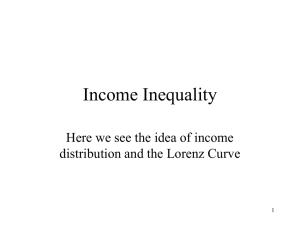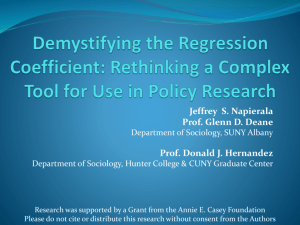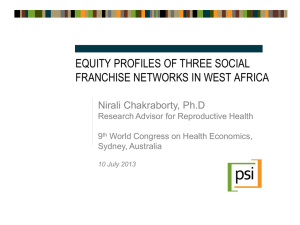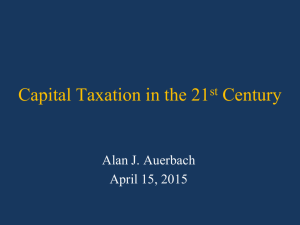Children's Employment Rates at Age 30 by Gender and
advertisement
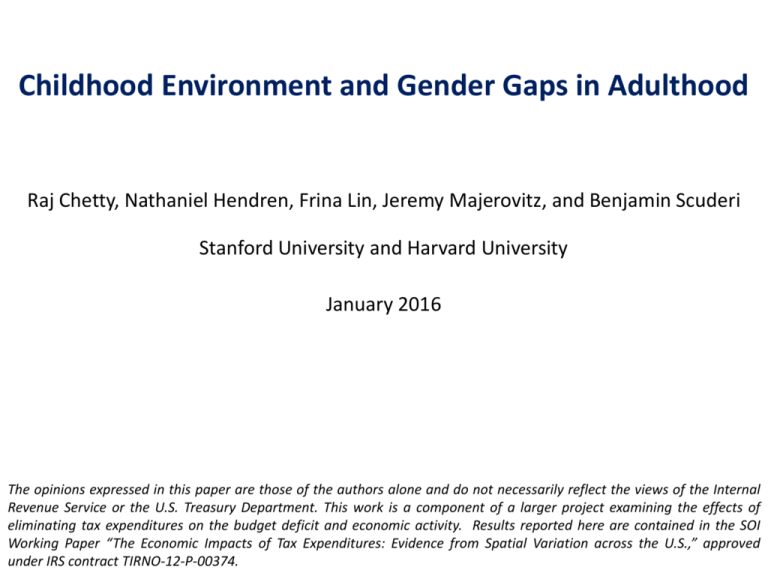
Childhood Environment and Gender Gaps in Adulthood Raj Chetty, Nathaniel Hendren, Frina Lin, Jeremy Majerovitz, and Benjamin Scuderi Stanford University and Harvard University January 2016 The opinions expressed in this paper are those of the authors alone and do not necessarily reflect the views of the Internal Revenue Service or the U.S. Treasury Department. This work is a component of a larger project examining the effects of eliminating tax expenditures on the budget deficit and economic activity. Results reported here are contained in the SOI Working Paper “The Economic Impacts of Tax Expenditures: Evidence from Spatial Variation across the U.S.,” approved under IRS contract TIRNO-12-P-00374. Introduction Differences between men and women in earnings, employment, and other outcomes in adulthood have been widely documented [e.g., Darity and Mason 1998, Altonji and Blank 1999, Blau and Kahn 2000, Goldin, Katz, and Kuziemko 2006, Goldin 2014] Explanations for these gender gaps focus on labor market factors: e.g., occupational choice, fertility patterns, wage discrimination Recent work has shown that effects of family background and environment on child development also vary by gender [e.g., Entwisle, Alexander, and Olson 2007, Bertrand and Pan 2011, DiPrete and Jennings 2012, Autor et al. 2015, Mitnik et al. (2015)] We connect these two literatures by examining the role of childhood environment on gender gaps in adulthood Overview We document three facts using tax data for the 1980-82 birth cohorts 1. Boys who grow up in poor families are less likely to work than girls 2. Gender gaps vary substantially across areas where children grow up Studying families who move reveals that this variation is primarily due to causal effects of childhood environment [Chetty and Hendren 2015] 3. Spatial variation in gender gaps is highly correlated with proxies for neighborhood disadvantage Low-income boys who grow up in high-poverty, high-minority areas work less than girls Gender gaps observed in adulthood have roots in childhood, perhaps because poverty during childhood is particularly harmful for boys Outline 1. Data 2. National Statistics on Gender Gaps by Parental Income 3. Local Area Variation in Gender Gaps by Where Kids Grow Up 4. Mechanisms and Discussion Data Data source: de-identified data from 1996-2012 population tax returns [Chetty, Hendren, Kline, Saez 2014; Chetty and Hendren 2015] Children linked to parents based on dependent claiming Focus on children in 1980-1982 birth cohorts, who are age 30 when we examine outcomes in adulthood Approximately 10 million children Variable Definitions Parent income: mean pre-tax household income between 1996-2000 For non-filers, use W-2 wage earnings + SSDI + UI income Children’s outcomes: Employment: presence of a W-2 form Earnings: total wage earnings reported on W-2’s Robustness check: measure self-employment income using data from Schedule C (noting that SE income often misreported) National Statistics on Gender Gaps by Parent Income Percent Employed 70 80 90 Children’s Employment Rates at Age 30 by Gender and Parent Income Percentile 60 Male-Female Difference Parent p10: -2.1% Parent p50: 3.8% Parent p90: 3.1% 0 20 40 60 Parent Household Income Percentile Male Female 80 100 Percent with Positive W-2 or Schedule C Income 60 70 80 90 Children’s Employment Rates at Age 30 by Gender and Parent Income Percentile Including Self-Employment (Non-Zero Schedule C Income) Male-Female Difference Parent p10: -4.3% Parent p50: 2.2% Parent p90: 2.0% 0 20 40 60 Parent Household Income Percentile Male Female 80 100 Percent Employed 70 80 90 Children’s Employment Rates at Age 30 by Gender and Parent Income Percentile Single Parent Households 60 Male-Female Difference Parent p10: -4.5% Parent p50: -1.3% Parent p90: -0.1% 0 20 40 60 Parent Household Income Percentile Male Female 80 100 Percent Employed 70 80 90 Children’s Employment Rates at Age 30 by Gender and Parent Income Percentile Married Parent Households 60 Male-Female Difference Parent p10: 3.2% Parent p50: 5.4% Parent p90: 3.3% 0 20 40 60 Parent Household Income Percentile Male Female 80 100 W-2 Earnings ($) 60000 40000 80000 W-2 Wage Earnings at Age 30 by Gender and Parent Income Percentile 20000 Male-Female Difference Parent p10: $5,544 Parent p50: $7,602 Parent p90: $9,770 0 20 40 60 Parent Household Income Percentile Male Female 80 100 Interpreting Gender Gaps by Parent Income Why is low parental income associated with particularly lower outcomes for boys relative to girls? In particular, why do we see a “reversal” in employment rates One explanation: differential effects of childhood/family environment Ex: poor boys substitute toward crime while girls do not Alternative explanation: other factors that are correlated with poverty and have differential effects by gender Ex: Blacks more likely to grow up in poor families and black men are significantly more likely to be incarcerated than white men Racial differences could be due to differences in childhood environment, but may also be due to factors such as discrimination in labor market Interpreting Gender Gaps by Parent Income To isolate effects of childhood environment, analyze local area variation in gender gaps based on where kids grew up Motivation: substantial variation in children’s outcomes across counties and commuting zones in the U.S. Analysis of families who move reveals that this spatial variation primarily reflects causal effects of childhood environment [Chetty and Hendren 2015] Childhood environment matters conditional on where kids live as adults Building on this approach, examine how gender gaps vary based on where children grow up Local Area Variation in Gender Gaps by Where Kids Grow Up Local Area Variation Begin by estimating gender gap in employment rates for children by parent quintile in each commuting zone (labor market) and county Classify children into areas based on where they grew up Where child was first claimed as a dependent by his/her parents First analyze “permanent residents” – children whose parents never move between 1996-2012 (later discuss movers) 60 Percent Employed 70 80 90 Children’s Employment Rates at Age 30 by Gender and Parent Income Quintile New York vs. Charlotte Commuting Zones 1 Females, Charlotte 2 3 4 Parent Household Income Quintile Females, NYC 5 60 Percent Employed 70 80 90 Children’s Employment Rates at Age 30 by Gender and Parent Income Quintile New York vs. Charlotte Commuting Zones 1 Females, Charlotte 2 3 4 Parent Household Income Quintile Females, NYC Males, Charlotte 5 Males, NYC Gender Gaps (M-F) in Employment Rates at Age 30 by Commuting Zone For Children with Parents in Bottom Quintile of National Income Distribution Note: Darker colors depict places where boys have lower employment rates than girls Gender Gaps (M-F) in Employment in the Bottom Parent Income Quintile Top 10 and Bottom 10 CZs Among 100 Largest CZs Top 10 CZs in Male-Female Diff. Rank CZ Bottom 10 CZs in Male-Female Diff. Gap Male Female Rank CZ Gap Male Female 1 Salt Lake City, UT 9.8 78.9 69.1 91 Milwaukee, WI -9.2 65.0 74.2 2 Bakersfield, CA 7.3 76.8 69.5 92 Dallas, TX -9.4 64.7 74.1 3 El Paso, TX 7.2 81.8 74.6 93 Washington DC -9.7 66.6 76.3 4 Brownsville, TX 5.8 82.6 76.8 94 St. Louis, MO -11.0 65.0 76.0 5 Erie, PA 4.1 75.6 71.5 95 Atlanta, GA -11.1 59.3 70.4 6 Eugene, OR 4.0 69.0 65.0 96 Virginia Beach, VA -11.6 65.0 76.6 7 Canton, OH 3.7 69.0 65.3 97 Charlotte, NC -12.4 60.1 72.5 8 Reading, PA 3.2 73.7 70.5 98 Raleigh, NC -13.6 59.9 73.5 9 Spokane, WA 2.5 70.3 67.8 99 Memphis, TN -15.3 59.2 74.5 10 Syracuse, NY 2.4 74.2 71.8 100 Richmond, VA -16.0 62.3 78.3 5 Standard Deviation of Employment Rates Across CZs By Gender and Parent Income Quintile 0 1 Standard Deviation (%) 2 3 4 Male 1st Quintile 2nd Quintile 3rd Quintile 4th Quintile 5th Quintile 5 Standard Deviation of Employment Rates Across CZs By Gender and Parent Income Quintile 0 1 Standard Deviation (%) 2 3 4 Male Female 1st Quintile 2nd Quintile 3rd Quintile 4th Quintile 5th Quintile Causal Effects of Place on Gender Gap Key lesson: where a child grows up matters most for poor boys Importantly, most of the variance across areas is driven by causal effects of place (rather than sorting) Chetty and Hendren (2015) identify causal effects of spending one more year growing up in each area by studying families who move Find gender-specific convergence in children’s outcomes When a family with a daughter and son moves to a place where boys do well, son does better in proportion to exposure time but daughter does not Variation based on where children grow up implies that gender gaps in adulthood are shaped partly by childhood environment Predictors of Spatial Variation in Gender Gaps Natural next question: what are the characteristics of areas for which exposure during childhood produces lower employment rates for low income boys relative to girls in adulthood? Correlate gender gap in employment rates for children with lowincome parents with various CZ-level characteristics Correlates of Spatial Variation in Employment Gender Gap Across CZs, Bottom Parent Income Quintile MIG LAB COLL TAX FAM SOC K-12 INC SEG Frac. Black Residents (-) Racial Segregation (-) Segregation of Poverty (-) Frac. < 15 Mins to Work (+) Mean Household Income (-) Gini Coef. (-) Top 1% Inc. Share (-) Student-Teacher Ratio (-) Test Scores (Inc Adjusted) (+) High School Dropout (-) Social Capital Index (+) Frac. Religious (+) Violent Crime Rate (-) Frac. Single Moms (-) Divorce Rate (-) Frac. Married (+) Local Tax Rate (+) State EITC Exposure (-) Tax Progressivity (+) Colleges per Capita (+) College Tuition (-) Coll Grad Rate (Inc Adjusted) (-) Manufacturing Share (-) Chinese Import Growth (-) Teenage LFP Rate (+) Migration Inflow (-) Migration Outflow (-) Frac. Foreign Born (-) 0 0.2 0.4 0.6 Magnitude of Correlation 0.8 1.0 Correlates of Spatial Variation in Employment Gender Gap Across CZs, Bottom Parent Income Quintile MIG LAB COLL TAX FAM SOC K-12 INC SEG Frac. Black Residents (-) Racial Segregation (-) Segregation of Poverty (-) Frac. < 15 Mins to Work (+) Mean Household Income (-) Gini Coef. (-) Top 1% Inc. Share (-) Student-Teacher Ratio (-) Test Scores (Inc Adjusted) (+) High School Dropout (-) Social Capital Index (+) Frac. Religious (+) Violent Crime Rate (-) Frac. Single Moms (-) Divorce Rate (-) Frac. Married (+) Local Tax Rate (+) State EITC Exposure (-) Tax Progressivity (+) Colleges per Capita (+) College Tuition (-) Coll Grad Rate (Inc Adjusted) (-) Manufacturing Share (-) Chinese Import Growth (-) Teenage LFP Rate (+) Migration Inflow (-) Migration Outflow (-) Frac. Foreign Born (-) 0 0.2 0.4 0.6 Magnitude of Correlation 0.8 1.0 Regression Estimates of Gender Gaps in Employment with Key Correlates For Children with Parents in the Bottom Quintile of National Income Distribution Male-Female Employment Gap Segregation of Poverty % Black % Single Mothers State FE Notes: Standard errors clustered by state. Significance levels: * p<0.05, ** p<0.01, *** p<0.001 (1) (2) -1.620 -1.948 (0.323) (0.197) -3.552 -3.335 (0.536) (0.563) 0.404 0.526 (0.666) (0.413) X Mechanisms Why do areas with concentrated poverty produce lower employment rates for poor boys relative to girls? One potential mechanism: growing up in poverty induces low-ability boys to select out of formal labor force Growing up in poverty reduces perceived return of formal work relative to crime/other activities more men drop out of labor force Consistent with this explanation, more segregated areas have higher rates of crime (correlation = 0.27 across CZs) Conclusion Gender gap in employment is now reversed for children who grow up in low-income families in the U.S. Men who grow up in poor families work less than women Gender gaps vary substantially across areas, with lower employment rates for boys in high-poverty, high-minority neighborhoods Findings suggest that childhood disadvantage may have particularly detrimental long-term effects on boys More broadly, understanding of gender gaps in adulthood can be enriched by starting analysis from childhood Can increasing segregation and inequality in America explain recent declines in male labor force participation rates? Download County-Level Data on Social Mobility in the U.S. www.equality-of-opportunity.org/data Appendix Percent with Positive W-2 or 1099 Income 60 70 80 90 Children’s Employment Rates at Age 30 by Gender and Parent Income Percentile Including Non-employee Compensation (Non-Zero Form 1099 Box 7 Income) Male-Female Difference Parent p10: -0.7% Parent p50: 4.9% Parent p90: 3.8% 0 20 40 60 Parent Household Income Percentile Male Female 80 100 50 60 Percent Employed 70 80 90 100 Children’s Employment Rates at Age 30 by Gender and Parent Income Percentile Sample Born after Jan 1, 1970 in the PSID 1st Quintile 2nd Quintile 3rd Quintile Male 4th Quintile Female 5th Quintile 40 Percent Employed 50 60 70 80 Children’s Employment Rates at Age 30 by Gender and Parent Income Percentile Trends for Children with Parents in the Bottom Income Quintile in the PSID, 1950-1984 1950 1960 1970 Child Year of Birth Male Female 1980 Individual Income Percentile 40 50 60 70 Mean Income Rank at Age 30 by Gender and Parent Income Percentile 30 Male-Female Difference Parent p10: 2.1% Parent p50: 7.2% Parent p90: 6.0% 0 20 40 60 Parent Household Income Percentile Male Female 80 100 Percent who Attend College 40 60 80 100 College Attendance by Gender and Parent Income Percentile 20 Male-Female Difference Parent p10: -16.1% Parent p50: -13.5% Parent p90: -4.7% 0 20 40 60 Parent Household Income Percentile Male Female 80 100 Gender Gap in Employment Rates: DC-Baltimore Combined Statistical Area Children with Parents in Bottom Quintile of National Income Distribution Hartford Baltimore Montgomery DC Prince George’s Charles Note: Darker colors depict places where boys have lower employment rates than girls Gender Gap in Employment Rates: Chicago Combined Statistical Area Children with Parents in Bottom Quintile of National Income Distribution McHenry Kane Du Page Cook LaPorte Will Bureau La Salle Note: Darker colors depict places where boys have lower employment rates than girls Gender Gap in Employment Rates: New York Combined Statistical Area Children with Parents in Bottom Quintile of National Income Distribution Ulster New Haven Bergen Monroe Bronx Suffolk Manhattan Queens Hudson Brooklyn Ocean Note: Darker colors depict places where boys have lower employment rates than girls Gender Gap in Employment Rates: Detroit Combined Statistical Area Children with Parents in Bottom Quintile of National Income Distribution Saint Clair Genesee Oakland Wayne Washtenaw Monroe Note: Darker colors depict places where boys have lower employment rates than girls 6 Standard Deviation of Employment Rates Across CZs By Gender and Parent Income Quintile for Single Parent Households 0 Standard Deviation (%) 2 4 Male Female 1st Quintile 2nd Quintile 3rd Quintile 4th Quintile 5th Quintile 6 Standard Deviation of Employment Rates Across CZs By Gender and Parent Income Quintile for Married Parent Households 0 Standard Deviation (%) 2 4 Male Female 1st Quintile 2nd Quintile 3rd Quintile 4th Quintile 5th Quintile Regression Estimates of Gender Gaps in Income Rank with Key Correlates For Children with Parents in the Bottom Quintile of National Income Distribution Male-Female Mean Income Rank Gap Segregation of Poverty % Black % Single Mothers State FE Notes: Standard errors clustered by state. Significance levels: * p<0.05, ** p<0.01, *** p<0.001 (1) (2) -2.485 -2.231 (0.246) (0.186) -1.311 -1.820 (0.410) (0.449) -0.217 0.288 (0.516) (0.391) X Regression Estimates of Gender Gaps in the Causal Effect on Income Rank For Children with Parents in the Bottom Quintile of National Income Distribution Male-Female Income Rank Causal Effect Gap Segregation of Poverty % Black % Single Mothers State FE Notes: Standard errors clustered by state. Significance levels: * p<0.05, ** p<0.01, *** p<0.001 (1) (2) -2.464 -2.780 (0.576) (0.556) -0.452 1.389 (0.777) (1.326) 0.350 -0.300 (0.743) (0.866) X


